
(No) Més que football
 Petra Malfertheiner
Petra Malfertheiner
There is a place in the EU where people celebrate Russian victory. A place where Europeans sing and dance to songs of the Red Army choir. A place where the police tell pro-Ukrainian activists they had better roll up their flags and leave.
This place is Narva, located in eastern Estonia. A town, a castle, a river. And beyond the river - Russia. On the Russian riverbank, speakers, a stage, and a screen facing Estonia were set up on the 9th of May, so that Narva’s residents could celebrate the soviet victory over Nazi Germany with the people from Ivangorod, the town on the other side of the river. ‘It is the first time this day has been celebrated jointly’, a moderator said in his opening speech, ‘but I hope it will become a tradition'. His words carried across the river and were answered with cheers and applause. People waved at each other, on both sides. Up to 1991, both communities were citizens of the Soviet Union and not separated by an international border. And until border checks were tightened in 2022, even that border could be easily crossed since many of Ivangorod’s and Narva’s residents had documents which allowed them to enter both Russia and the EU.
A spirit of former unity dominated the Victory Day celebrations which were made up of concerts, dance shows, speeches, and video screenings. At some point during the chorus of ‘Kalinka’ - one of many Red Army songs played, the moderator shouted, ‘now all together’, whereupon those in Narva started to sing, dance, and clap alongside those in Ivangorod. Meanwhile, on the screen, one could see black-and-white videos of tanks rolling over wastelands and planes dropping bombs.
The way of celebrating Victory Day has changed in past years from commemorating fallen ancestors to exhibiting Russia’s past and present military power.1 This year, though, celebrations were kept on the low in Russia as the regime feared that instead of carrying pictures of Second World War victims through the streets, people would showcase those of relatives killed in Ukraine, thus revealing the scope of their loss. In Estonia, organized public gatherings on the 9th of May were even prohibited by law, albeit for different reasons: the government feared that such gatherings would provoke and offend in the current context. The display of the black-and-orange St. George’s ribbon – a symbol of the Russian army usually worn on Victory Day – could be fined more than 1000 Euros. This decree was criticized by none other than the Estonian president: ‘the parliament should not legislate based on moods of the moment, even if they are the right moods.’2 He would have been right about the ‘moods of the moment’ being opposed to celebrating Victory Day had he referred explicitly to the moods of Estonia’s majority group. Ethnic Estonians’ attitude to Victory Day had always been ambivalent, for while they do mourn for their relatives and celebrate Nazi Germany’s defeat, they also see the end of that war as the beginning of half a decade of Soviet occupation. Thus, many Estonians were not averse to replacing Victory Day with ‘Europe Day’, to celebrate peace and unity and to raise funds for Ukraine.
In Narva, conversely, most residents are ethnically or nationally Russians and hence attribute great personal and political meaning to Victory Day. This explains why so many joined the celebration that Ivangorod’s mayor had organized and why some had the Russian flag pinned to their clothes. By contrast, little blue and yellow was to be seen. Only the friends with whom I had travelled to Narva were wearing those colours. One of them had also brought a Ukrainian flag with. A few people approached us, saying: ‘Slava Ukraini’ – glory to Ukraine. The negative reactions, however, outnumbered encouraging ones: most people shook their heads, raised their fists, showed us the middle finger, and threw stones and empty beer cans. Many told us to leave, even the police: it was for our own safety, they said, we should put our own lives first.
Estonia’s past, and its policies regarding ethnic minorities help understand the heated atmosphere in Narva. Roughly 70% of the country are ethnic Estonians and 23%ethnic Russians. Contrastingly, the demographic composition in Narva, with its 55,000 inhabitants making it the third-largest city in the country, is totally different: ethnic Estonians only make up 5% of the population while the rest are ethnic Russians. The Estonians who had lived in Narva but fled during the Second World War were not allowed to return to the destroyed city after the Soviet annexation of the Baltics in 1944. Instead, the newly built blocks were populated with Russian workers. Their descendants still constitute most of the city’s residents. However, they are not a homogenous group in terms of citizenship: over a third are citizens of the Russian Federation, a bit under half are Estonian citizens, and about 15% have a ‘grey passport’, which is a form of ‘undefined citizenship’ common to the Baltics. In 1991, the Estonian government declared independent Estonia a restoration rather than a succession of the pre-1940 state and, that entailed all citizens to be seen as Estonians. With one major exception: those who had settled in Estonia during the occupations and their descendants – almost a third of the population – were considered stateless. They could become Estonians via naturalization, yet that was not an easy path: knowledge of the language and the Constitution and professed loyalty to the state were only some of the prerequisites. This policy led to an exceptionally high proportion of stateless people. Recently, the government has made attempts to improve the situation, especially for minors. However, there remains a large number of grey passport holders – many of whom are so by choice, for the status allows them to move freely between the EU and Russia.
There are other cleavages than citizenship between ethnic Estonians and Russian speakers who often live in ethnically homogenous areas, like Narva. Many people here feel alienated from the rest of Estonian society. Some residents explain this arises from a lack of higher-level language courses, which would open up job opportunities and allow the consumption of Estonian culture and media.3 This indicates that linguistic and cultural assimilation is perceived as necessary for members of the minority to integrate – rather than for them being able to actively participate in society using and cultivating their own mother tongue.
Hence, many ethnic Russians have ambivalent feelings about the country in which they live. They realize that their living standards are higher than if they lived in Russia today. Yet many feel ostracized in modern Estonia and nostalgic for Soviet times or at least for undisputed citizenship and the politically and culturally dominant position they had enjoyed. Hence, so many rushed to the riverside on the 9th of May to celebrate the past and to embrace the Russian part of their identity. One could perhaps see this as an indication that Estonia’s territorial and political integrity is threatened, that Narva offers fertile soil for secessionism or for a Russian invasion.4 One could also understand why the government fears that such gatherings provoke and offend, especially as attacks on activists suggest that not only past, but also present, Russian military operations are celebrated or at least condoned.
The chief of the Estonian Internal Security Service takes a calmer approach: the riverside concert ‘is okay, let people feel good.’ This statement might sound lax, yet it reflects a reasonable reluctance to enforce the ban on public gatherings harshly. If for the people in Narva it is important to celebrate Victory Day, which they cannot do in an organized way in Estonia, then let them stand by the river and sing along to songs played on the other side. After all, preventing people from expressing their feelings of belonging and commemorating the past, as controversial and instrumentalized that may be, would only lead to resentment, and thus greater fragmentation and instability within Estonia.
Victory Day celebrations in NarvaVideo: Antilia Wyss | All rights reserved
The 9th of May and the discord about how to deal with this day – and with the people wanting to celebrate it – raises bigger questions of how Estonia’s ethnic groups can live together peacefully despite their difficult past and the rising tensions in the present. It is not easy for ethnic Estonians to acknowledge ethnic Russians – who were seen as invaders and occupiers until not long ago – as a minority group with a right to protect and promote their culture and language - especially as ethnic Estonians have themselves only been able to freely cultivate their own culture and language instead of Russian since the early 90s. This situation is further complicated now that the promotion of any form of Russian culture is frowned upon in the West. However, to avoid further fragmentation, it takes more than just tolerating ‘Russianness’ and more than just turning a blind eye to it like the police did to the man waving a St. George’s banner in Narva. Rather, active measures to strengthen societal cohesion and to ensure political stability in Estonia are needed. This would include creating space for double and multiple identities and thus integrating the Russian-speaking minority without requiring cultural and linguistic assimilation. Giving ethnic Russians a space to be Russian and Estonian or Russian in Estonia, could help build a strong and confident Russian speaking community outside of Russia. Then, people would perhaps no longer need or want to watch Russian war videos and hear propagandist speeches when commemorating their past on the 9th of May.

This content is licensed under a Creative Commons Attribution 4.0 International license.